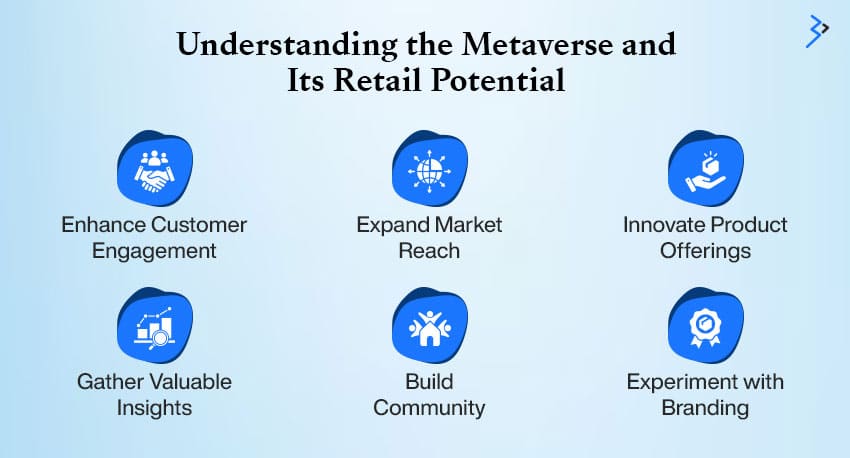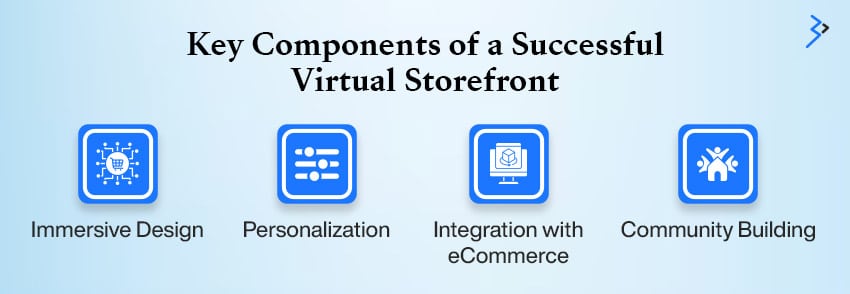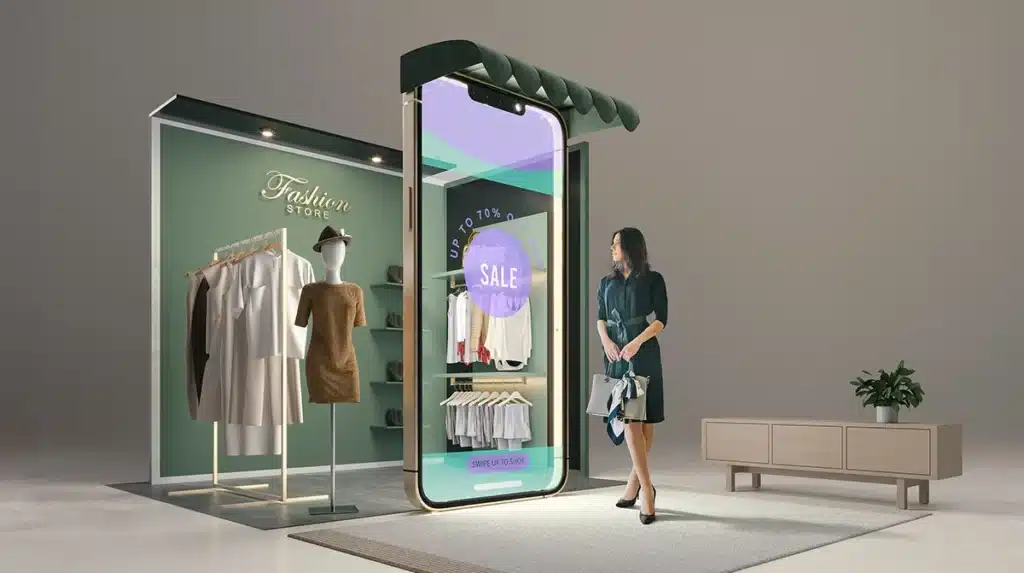Imagine stepping into a store where the walls shift with your preferences, products come alive with interactive stories, and your avatar can try on outfits before you buy them—all without leaving your home. This isn’t a scene from a sci-fi movie; it’s the emerging reality of retail in the metaverse.
The metaverse revolutionizes how brands connect with consumers, offering immersive experiences that blend the physical and digital worlds. As technology advances and consumer expectations evolve, virtual storefronts are essential for brands aiming to stay ahead in the competitive retail landscape.
This comprehensive guide will explore the metaverse’s impact on retail, showcase pioneering brand examples, and provide actionable insights for businesses looking to establish their presence in this dynamic digital frontier.
Understanding the Metaverse and Its Retail Potential

What Is the Metaverse?
The metaverse is more than a futuristic concept—it’s a dynamic digital universe blending virtual and physical realities. In this immersive space, users engage through avatars, interact with 3D environments, attend events, and shop in real time. The metaverse is quickly becoming a new stage for brand storytelling and customer engagement, powered by technologies like VR, AR, and blockchain services.
So, what does this mean for retailers? It means opportunity—big, boundary-breaking opportunity. Here’s why the metaverse matters:
- Enhance Customer Engagement: Create immersive, gamified experiences that capture attention and boost brand loyalty.
- Expand Market Reach: Reach a global audience 24/7, without being limited by geography or physical infrastructure.
- Innovate Product Offerings: Launch digital-first products, virtual wearables, and exclusive NFTs for new revenue streams.

- Gather Valuable Insights: Track real-time interactions to understand consumer behavior and personalize the shopping experience.
- Build Community: Use virtual spaces to host events, foster social interaction, and strengthen brand connection.
- Experiment with Branding: Test new concepts, visual styles, and experiences without traditional production costs.
The metaverse is not just the next digital channel—it’s a paradigm shift. Retailers who embrace it now will lead the way in crafting the future of commerce. Whether you’re launching a virtual flagship store or collaborating with metaverse platforms, stepping into this space offers endless ways to innovate, engage, and grow.
Pioneering Brands Leading the Metaverse Retail Revolution

As the metaverse evolves from concept to reality, forward-thinking brands are already paving the way with innovative virtual experiences that blur the lines between digital and physical retail.
These trailblazers are not only enhancing how customers interact with their products but also setting new benchmarks for immersive commerce. By integrating AI-powered Omnichannel Retail Software Solutions, they are creating seamless, intelligent, and personalized experiences. Here’s a look at how some of the world’s most iconic companies are leading the charge in metaverse retail.
1. Nike: Nikeland on Roblox
Nike entered the metaverse with a powerful presence through Nikeland, hosted on Roblox. This virtual world invites users to engage in mini-games, socialize, and explore Nike-themed environments.
- Gamified Experiences: Users can take part in interactive sports challenges like tag and dodgeball.
- Digital Try-Ons: Avatars can wear Nike gear, offering a new dimension to product placement.
- Brand Integration: The platform seamlessly weaves Nike’s brand identity into entertainment, lifestyle, and community.
By aligning with youth culture and digital innovation, Nike has redefined how athletic wear is promoted and experienced in a virtual context.
2. Gucci: Gucci Garden and Gucci Town
Gucci has taken luxury fashion into the metaverse with two standout experiences—Gucci Garden and Gucci Town on Roblox.
- Immersive Storytelling: These spaces offer users a visual journey through the brand’s history, values, and creative vision.
- Limited Edition Digital Wearables: Gucci launched exclusive items like the digital Dionysus Bag, which once sold for more than its real-world version.
- Interactive Spaces: In a digitally styled environment, users can explore galleries, engage in challenges, and connect with others.
Gucci’s ventures demonstrate how virtual worlds can elevate brand storytelling and create unique, collectible experiences.
3. IKEA: Virtual Showrooms with AR
While not based in a typical metaverse, IKEA is pioneering virtual retail through its augmented reality (AR) solution—IKEA Place.
- True-to-Scale 3D Models: Customers can use their smartphones to place virtual furniture in their own space.
- Enhanced Decision Making: Shoppers visualize how products fit and match their rooms, improving confidence before purchase.
- Bridging Online and Offline: IKEA effectively merges digital convenience with physical product interaction.
This AR-powered approach is a strong example of practical innovation in the virtual shopping experience.
4. Ralph Lauren: Digital Fashion in Zepeto and Fortnite
Ralph Lauren has embraced the metaverse by stepping into popular virtual platforms like Zepeto and Fortnite.
- Digital-Only Clothing Lines: The brand launched apparel collections for avatars, tailored to younger, tech-savvy audiences.
- Virtual Fashion Shows: Ralph Lauren reimagined the runway by hosting immersive fashion events in virtual environments.
- Youth Engagement: These efforts open doors to Gen Z and Gen Alpha, embedding the brand in digital-native culture.
By digitizing its classic aesthetic, Ralph Lauren stays relevant while exploring fresh creative frontiers.
5. Samsung: Samsung 837X in Decentraland
Samsung brought its flagship store concept to the metaverse with Samsung 837X, a virtual experience in Decentraland.
- Interactive Product Displays: Visitors explore new devices and features in 3D.
- Live Events & Quests: The space hosts live music events, treasure hunts, and more to encourage repeat visits.
- Sustainability Messaging: Samsung weaves eco-conscious narratives into the virtual experience.
This venture combines digital retail with brand activism and community engagement in a truly immersive way.
These pioneering brands are not just experimenting—they’re building the foundation of future retail. By embracing the metaverse, they’re creating new touchpoints, enhancing customer loyalty, and redefining how we shop in an increasingly virtual world.
Read More – How Metaverse and AI Are Changing The Face Of Digital Transformation
Key Components of a Successful Virtual Storefront

As brands venture into the metaverse, building a virtual storefront isn’t just about setting up shop—it’s about crafting an immersive, interactive, and engaging experience that rivals (and often enhances) physical retail. Here are the key components that define a successful virtual storefront:
1. Immersive Design
The foundation of a compelling virtual store lies in its ability to captivate and engage users through rich, interactive environments.
- 3D Modeling: Use high-quality, photorealistic 3D models to showcase products from every angle, allowing users to explore details just like in a physical store.
- User Navigation: Create an intuitive and fluid interface that makes browsing seamless. Think of clickable floor maps, teleportation points, or guided tours.
- Interactive Elements: Incorporate features like virtual try-ons for apparel, product customization tools, or AR app development services views that allow users to personalize their shopping journey.
2. Personalization
Tailoring the experience to individual user preferences builds emotional connections and boosts conversions.
- Data-Driven Customization: Use behavioral data to recommend products, adjust layouts, or present targeted promotions based on user interests.
- Avatar Integration: Allow users to shop as their avatars, with saved preferences, sizes, and past purchases guiding their experience.
3. Integration with eCommerce
A beautiful virtual space means little if it doesn’t lead to smooth, secure transactions.
- Secure Payment Systems: Embed trusted payment gateways that support various currencies and even blockchain-based payments.
- Real-Time Inventory Management: Sync product availability across platforms to prevent cart abandonment due to stock issues.
- Customer Support: Offer live chat with agents, AI-driven chatbots, or even virtual assistants to guide users throughout their journey.
4. Community Building
A virtual storefront should be more than a place to buy—it should be a destination where users connect, create, and return.
- Social Features: Enable live chats, shared shopping experiences, or virtual meetups to turn shopping into a social activity.
- Events & Launches: Host exclusive product drops, fashion shows, or workshops, encouraging engagement and FOMO-driven participation.
- User-Generated Content: Let users customize and showcase their avatars, spaces, or style using your products, then share them with others.
Together, these components form the backbone of a successful virtual storefront. Brands that invest in immersive design, smart personalization, seamless eCommerce integration, and a vibrant community will attract attention and drive loyalty and long-term engagement in the metaverse.
Challenges and Considerations
While the metaverse holds exciting potential for retailers, launching and sustaining a virtual storefront isn’t without its hurdles. Brands must navigate technical, ethical, and strategic challenges to succeed in this new digital frontier.
Here’s a quick overview of the key considerations:
| Challenge | Consideration |
| Technical Limitations | High development costs and the need for skilled developers and 3D artists. |
| Accessibility | Reaching users with low-end devices or limited internet connectivity. |
| Data Privacy & Security | Ensuring GDPR compliance and protecting user data from breaches. |
| Measuring ROI | Defining success with new metrics like user engagement, dwell time, and loyalty. |
Tackling these challenges thoughtfully is essential for building sustainable, user-centric virtual storefronts that deliver both innovation and value.
Steps to Launching Your Virtual Storefront

Building a virtual storefront in the metaverse is an exciting opportunity to transform how you connect with customers. However, success requires more than simply going digital—it involves a strategic, thoughtful approach. Here’s a step-by-step guide to launching your virtual store:
Step 1: Define Objectives
Start by identifying your goals. Are you aiming to boost brand visibility, drive eCommerce sales, foster customer engagement, or launch new products? Clear objectives will guide every decision—from design to marketing.
Step 2: Choose the Right Platform
Select a metaverse platform that matches your brand’s personality and audience.
- Roblox: Popular with younger demographics
- Decentraland: Ideal for crypto-savvy users
- Custom Builds: Tailored experiences with full control and branding
Step 3: Design the Experience
Work with 3D designers and UX specialists to craft an immersive, intuitive space. Focus on:
- Interactive features
- Aesthetically aligned visuals
- Seamless user navigation
Step 4: Integrate eCommerce Capabilities
Enable purchases within your virtual store with features like:
- Secure payment gateways
- Real-time inventory syncing
- AR/VR product previews
Step 5: Promote Your Virtual Store
Create buzz with a multi-channel strategy:
- Leverage influencers
- Run teaser campaigns on social media
- Host virtual launch events
Step 6: Monitor and Optimize
Track user behavior and collect feedback to make ongoing improvements. Use analytics to refine layout, content, and engagement features.
Following these steps, brands can create dynamic, impactful virtual storefronts that leave a lasting impression and drive meaningful results.
Read More – Personalized Data Experiences with Power BI Reports for Multiple Metaverse Avatars
The Future of Retail in the Metaverse
The retail landscape is on the brink of a digital renaissance, and the metaverse is leading the charge. As immersive technologies mature, virtual environments will become a natural extension of how brands connect with consumers, blending entertainment, community, and commerce into one dynamic experience.
Forward-thinking retailers already understand that the metaverse isn’t a passing trend—it’s the next evolution of digital engagement. By embracing this transformation now, brands can stay ahead of the curve, redefine customer interactions, and unlock new revenue streams in previously unimagined ways.
Emerging Trends to Watch:
| Emerging Trend | Key Details |
| Integration of AI and Machine Learning | – Powers personalized shopping journeys- Predictive product recommendations- Intelligent virtual assistants adapting in real-time |
| Expansion of Virtual Goods and NFTs | – Digital collectibles and branded wearables- Exclusive NFT drops- New ways for customer loyalty and brand ownership |
| Enhanced AR and VR Technologies | – More realistic virtual stores- Haptic feedback for immersive experiences- Lifelike avatars and interactive product exploration |
| Cross-Platform Interoperability | – Seamless transitions across platforms (Roblox, Decentraland, custom metaverses)- Consistent branding- Unified customer experiences |
In short, the future of retail lies in creating value beyond transactions through storytelling, innovation, and unforgettable experiences. Brands that act now will not only stay relevant but also lead the way in this exciting new era of commerce.
Conclusion: Embracing the Metaverse Retail Opportunity
The metaverse presents a transformative opportunity for retailers to redefine the shopping experience. By building virtual storefronts, brands can engage with consumers innovatively, offering personalized, immersive, and interactive experiences that bridge the gap between the physical and digital worlds.
As the metaverse continues to grow, staying informed and adaptable will be key to success. Embrace the possibilities, invest in the right technologies, and create experiences that resonate with your audience in this exciting new frontier of retail.
Related Articles
-
How AEM Helps Business to Work Through Author and Publisher Environments
A powerful content management system that simplifies digital content management in author and publisher environments is Adobe Experience Manager (AEM). It ensures that only authorized, optimized content is published on
-
7 Ecommerce Websites for Your Inspiration for Design Success
Over 50 milliseconds have passed since the moment you clicked on this link, and visitors have developed an opinion about your ecommerce website in that fraction of a second. 88%
-
The Ultimate Clash of eCommerce Giants: WooCommerce vs Magento vs Shopify
You might be surprised why only these three solutions are considered and compared over here. Well, these are the most famous eCommerce platforms with over 2.5M online stores in the




